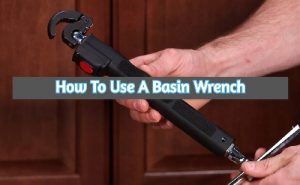 If you’ve seen anyone working on a basin and trying to install or remove a faucet, you’ll know that it’s a painful job. The main reason for this is that the nuts and bolts used to hold a faucet together are often located on the underside of the sink. This puts them in an awkward position.
If you’ve seen anyone working on a basin and trying to install or remove a faucet, you’ll know that it’s a painful job. The main reason for this is that the nuts and bolts used to hold a faucet together are often located on the underside of the sink. This puts them in an awkward position.
However, there is a solution- the basin wrench. It is a wrench specifically made for this job, and it does it well. This article will show you how to use it.
Basin Wrench Parts
Before we get into the details of how to use your trust basin wrench, let’s look at the different parts and get an idea of what makes it special. According to Torquewrencenter, unlike torque wrench, there are two essential parts of a basin wrench. They are:
1. Wrench Head
Or the head is one of the main parts of the basin wrench. Like other wrench heads, this is used to grip and turn the nuts in the sink. It resembles a claw of sorts, and this allows it to get a good grip when used to remove or install a faucet.
The main difficulty is of using other tools is that the nuts and bolts are in an awkward position that doesn’t leave a lot of space to maneuver your hands and tools. Thus it is hard to get a good grip at times with a normal wrench, but basin wrenches overcome the grip issue.
2. Shaft And T-Bar
As stated before, the awkward location doesn’t leave much space to maneuver your hands or tools. The basin wrench has a long shaft connecting to the wrench head. The other end of the shaft has a T-bar that can be gripped with your hands and makes turning the wrench easier.
The length of the shaft does allow a person to easily reach the nuts or screws and prevents the person from working in a confined space. Some basin wrenches have variable shaft lengths.
How to Use A Basin Wrench
Now that you’re familiar with the parts of a basin wrench, we can see how to operate it.
1. Get Your Basin Wrench Ready
The wrench head of your basin wrench has a single claw that can be unhooked. Unhook it before using it to ensure that your wrench can grip the nut. Connect the T-bar to your shaft if they are separated.
2. Align The Wrench Head
Locate the nut that needs to screwed or unscrewed. Then align the wrench head to the nut. If you are trying to unscrew a nut, you should have the opened claw head facing to the right. If you’re trying to screw in a nut, you should make sure the claw head is facing to the left. This is important for the next step.
3. Connecting The Wrench
Once you have aligned the wrench head, carefully attach it to the mounting nut on the underside of the sink. Give a small twist and see if the wrench stays or slips off. If it slips off, it means that the wrench head hasn’t properly been connected to the mounting nut, and you need to try again. If it stays then, it means the wrench head has gripped the mounting nut.
4. Turning The Wrench
Once you’ve connected the wrench to the nut, you can proceed to turn it to either screw or unscrew it. This step might be a bit comfortable as you will need to lie down on your back underneath the sink to properly grip the basin wrench.
After assuming that position, hold the T-bar using both your hands and begin to turn. If you’re attempting to loosen the nut, you will need to turn the wrench counterclockwise. If you’re attempting to tighten the nut, you will need to turn the wrench clockwise.
Simply repeat these steps whenever you need to screw or unscrew the mounting nuts on your sink. This is the main procedure; however, there is some additional information that you should keep in mind.
Additional Information
Most shafts have an adjustable T-bar. This allows you to change the positioning of the T-bar so you can have a lengthier side of the bar on either the left or right side. This allows more flexible operation, which is important considering how difficult it can be to operate it on your back.
You can use oil or rust remover to make loosening screws much easier. Rust can sometimes prevent the nuts from coming off.
Conclusion
As you can see, a basin wrench is a handy tool to have even if it’s a one-trick pony. Operating it is easy though the lying down on your back can be uncomfortable at times, so don’t stress yourself out like that. If you also know how to properly use a torque angle gauge, that will also be helpful for you.
Leave a Reply